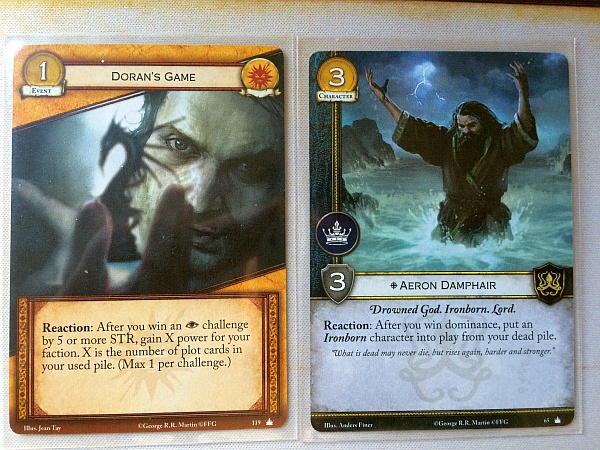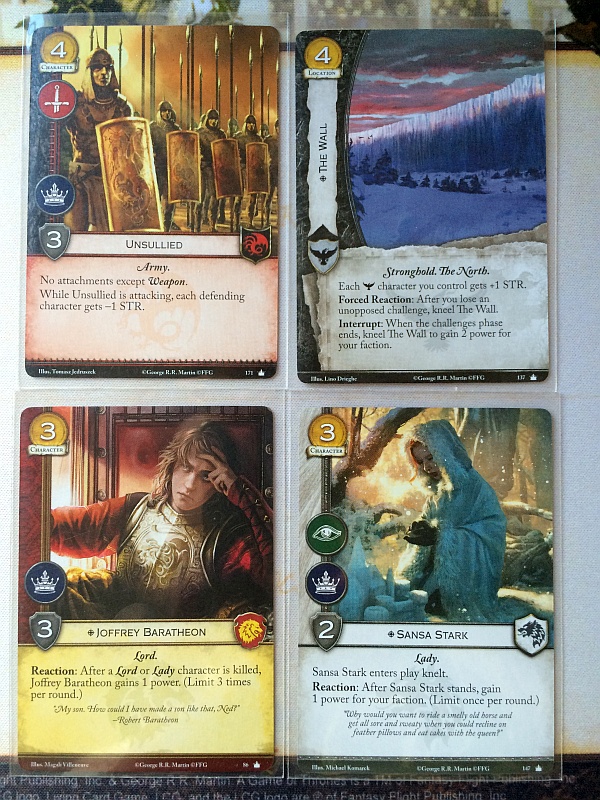A Game of Thrones: The Card Game (2nd Edition) Review
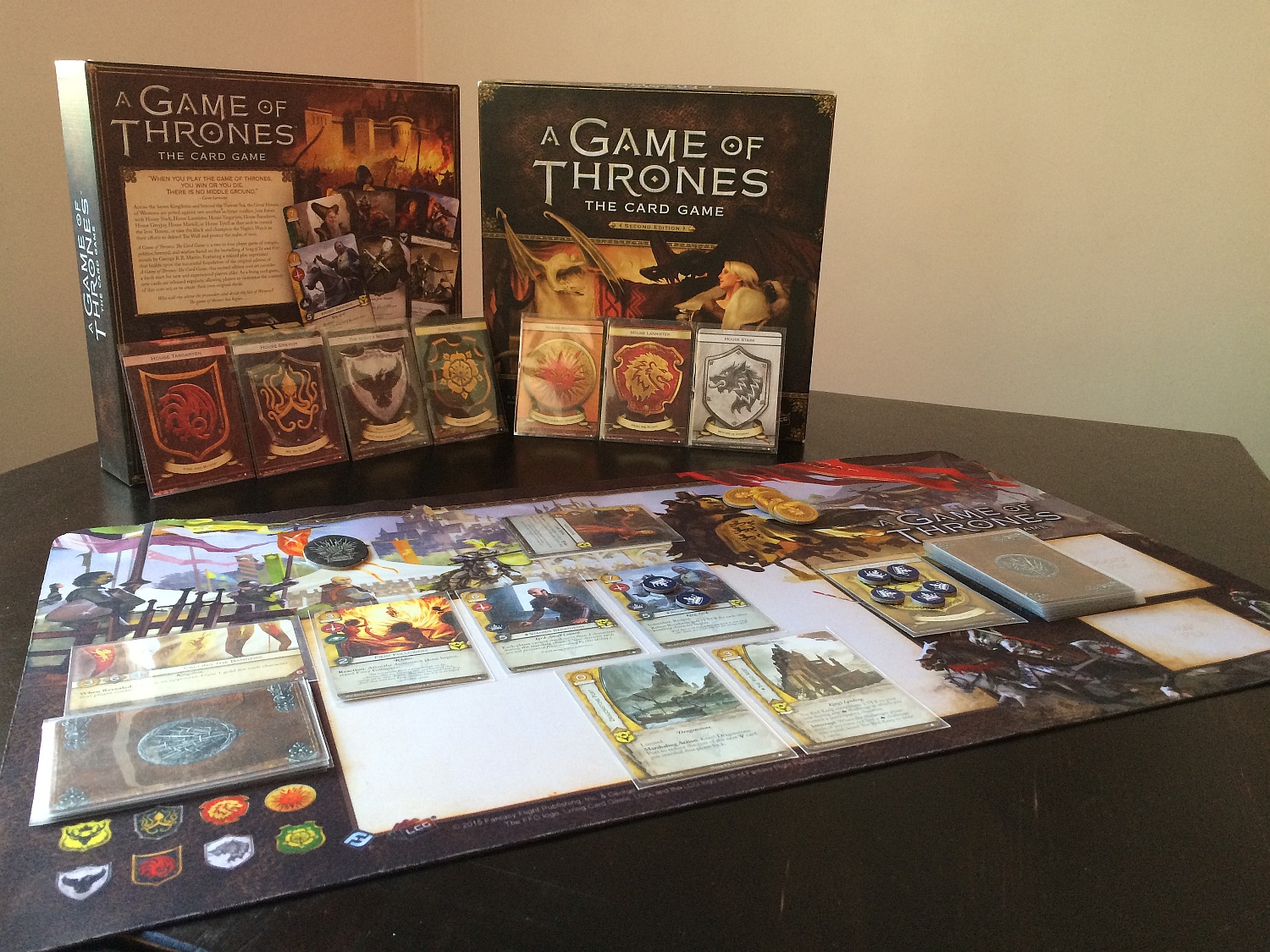
What is it? Game of Thrones: The Card Game (2nd Edition) has the potential to be one of the most loved LCGs in the Fantasy Flight Collective. With a theme that is intricate and familiar to such a wide audience exposed to the mainstream media, a 2-4 player variance that is missing in many of its peers and a 13 year testing period of the first edition that will streamline many common faults in expanding card games, it seems a sure bet. Will this play out as expected or does the universe of George R.R. Martin have more surprises in store?
Tywin Lannister cursed under his breath. Stannis had beaten his fleets in the water and rained fire on his left flank, forcing his troops back to the Kings Road. He hadn’t factored Milisandre to be the force that caused his troops to kneel before her will as the might of R’hllor, The Lord of Light burnt through his troops morale. After burning Shireen at the stake, the Baratheon’s troops had mustered out of divine fervor or dire fire and while Tywin thought the latter the end result was a lack of troops to attack and defeat his enemies. His coin had dwindled after his latest plot and support that Stannis enjoyed from the Night’s Watch meant that he had little option than to summon his last commander. With the last coin spent, Tywin mustered Rob Stark and Grey wind to lead his Lannister Army to…
Wait, thats not how the story goes… Is it?
Originally released in 2002, Game of Thrones: The Card Game begun as a collectible card game much like Magic the Gathering. In 2008, it was re-released as Fantasy Flight Games inaugural batch of Living Card Games (LCG’s) which meant that players could buy packs of pre-determined cards allowing gamers to know exactly what cards they would be purchasing for definitive deck building strategies. The concept was evolutionary with four of the great houses included in the core set, and numerous monthly Chapter packs and big box expansions fleshing out the mythos of Westeros. Sevens years, two Awards and hundreds and thousands of plays later, we see the birth of the Second Edition. This brings jubilation and indignation in equal amounts to the gaming community, for those getting to join this crusade and those who watch their homes burn under the banner of progress.
Game of Thrones: The Card Game (2nd Edition) offers new players a core set with 8 houses playable out of the box: Stark, Lannister, Baratheon, Targaryen, Tyrell, Greyjoy, Martell and the Night’s Watch. You’ll choose a House Banner for yourself and compile yourself a deck of Characters, Events, Locations, and Attachments (around 60+ Cards) and then a set of 7 Plot Cards. Round by round, you and your opponent(s) will go through the various phases of war, deception and dominance until one of you controls 15 tokens of power. Cunning, subterfuge and deftly striking your enemy (possibly making them scream out: Cumon!, like when they saw the Red Wedding) will secure you the Iron Throne once Winter has come.
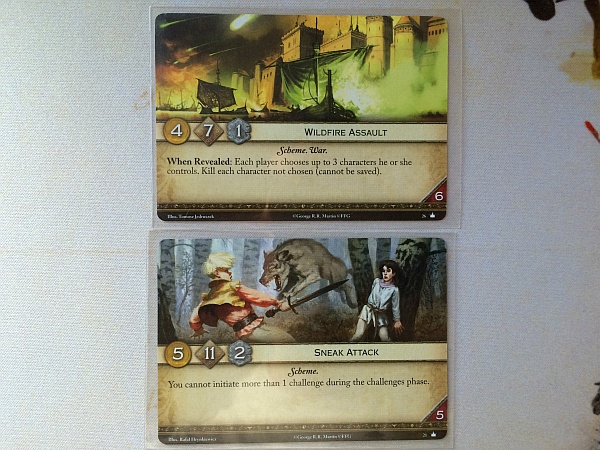
The Bloody Wildfire Assault will kill many characters in play, while Sneak prevents multiple challenges in a single round, but duplicates challenge rewards!
Without spreading out the war map in front of you to explain every tactical maneuver, I’m just going to play out some of the bloodiest and cruelist highlights of game play. Please note that I’ve only played the 2 player variant called “Joust” however reports have indicated that the 4 player “Melee” variant is an excellent game as well. Each round players will select a plot card from their selection of 7 which will decide who gets to choose to act first in the round, how much gold they have to spend, the potential damage of their plot and their allowance for reserves for the next skirmish. These plots may also trigger fiendish game changing conditions that can benefit the plotter and/or hinder the opponent.
Then, in player order decided by initiative, players will summon their house characters, locations and possibly attachments from their hand to the front lines, ensuring that the cost of marshaling these is within the budget set by the master of coin indicated by their plot card as well as any benefits from cards in play.
Following the battlefield being set, players will then initiate challenges against each other, based on the challenge abilities of their standing (untapped) characters in play. Each character has a strength value, and multiple cards with similar challenge abilities can be knelt (tapped) to initiate the challenge. After announcing attackers, the defending player must choose whether to kneel cards to defend against the particular challenge type, ensuring that these characters are able to defend with the requisite symbols.
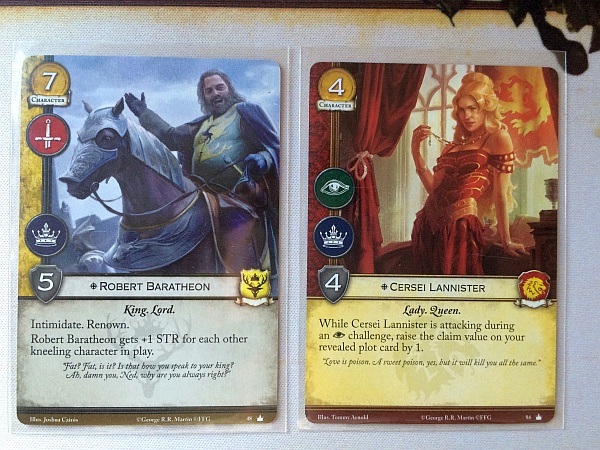
Robert was all about Military and Power, While Cersei seduces with Intrigue and Power. Truly a Power Couple
There are 3 types of challenges, with each player being able to only initiate each challenge type only once per round (if able).
Military Challenge – The cornerstone of any good war, symbolised by the red sword icon. If you win a military challenge, the opponent must choose a character from the field and place him/her in their dead pile.
Intrigue Challenge – Filthy, Filthy lies and deception are necessary to understand your enemies strengths and weaknesses. Losing an intrigue challenge allows the opponent to randomly discard a card from your hand.
Power Challenge – Pure strategic might and the control of Westeros by political force. When your power challenge crushes and opponent, they must relinquish one of their power token from their House to you!
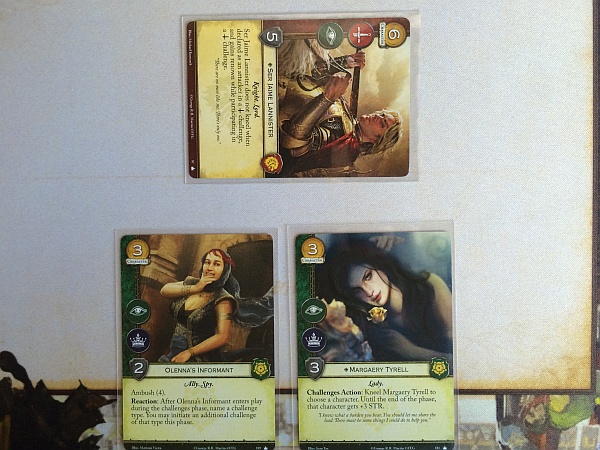
Jamie kneels to initiate his intrigue challenge of Strength 5 which would require both Margaery and the Informant to commit to defend!
After each player has completed their challenges, the front lines must be assessed for dominance. Players will then compare the strength of their standing (untapped) characters in addition to the number of coin in their coffers to the other and the house with the most strength will gain a power token for dominance.
After the Dominance Phase, all unspent coin is returned and all characters will stand (untap) and the plot phase will begin anew.
First player to accumulate 15 power tokens immediately wins the game and claims victory for their house. For a professionally produced video tutorial that Cardboard Quest does not have the budget for, we can thank Fantasy Flight Games.
Every Living Card Game has the secondary element of card selection and essentially the development of your play style. Want to starve your opponents of cards, and then sneak through their paltry defense? You’ll want to create an intrigue heavy deck and possibly some characters with sneak ability’s to bypass defenders: Allow me to introduce a Lannister and Greyjoy combination. Prefer the defensive play to soak up damage and deal it back late game? Maybe you want to combine the defensive dedication of the loyal Night’s Watch while adding just a touch of Martell to kill your enemies in their sleep. Game of Thrones: The Card game allows you to customized decks of a main House, with Banner assistance ( a limited selection of cards) from another house and then a splattering of neutral cards (mercenaries or turncoats like Varys and Littlefinger). With a limit of 3 cards of a single type per deck this allows you to build the army you want to crush your enemies, but for the casual player this may highlight the warning that comes with this LCG and almost every one from Fantasy Flight Games.
Deck optimisation is an art-form. There are sites like CardgameDB dedicated to players discussing their sessions, which cards they have used in combination and how to eliminate the excess weight in their armies in order to best destroy opponents in local and even national tournaments. Making sure you have three copies of a valuable character in your sculpted army ensures you’re more likely to get them to the table early with a 3 in 60 chance and create a working strategy that comes to fruition. You’ll need around 60 cards in a deck, as when you fail to draw cards, you have lost the game as well. Unfortunately, with a single core deck, you will only have single copies of most cards. While two copies of the core set will give you enough cards to make very competent decks that unlock a myriad of options for deck building, it’s taken as gospel by the dedicated Game of Thrones LCG Players that on a competitive level you’ll require 3 core sets. You can work around this with possibly 3 Core sets between 2 friends and each taking four factions, but its less than ideal. Having a single core is like someone scratching the tip of a very urgent itch for but a moments respite, leaving you craving for more.
This should not deter lovers of head to head deck building cards games at all, as this is one of the greatest of FFG’s living card games that I have had the pleasure of dealing to the table. Each chapter pack released promises to be a tender reunion with the fantasy world I fell in love with around 10 years ago. Each card is beautifully crafted with the utmost respect to the world that fans love and when you challenge, fail and see characters killed in military challenges, never to return to the battlefield, you feel a part of that world. For casual gamers, a Game of Thrones: The Card game (Second Edition) comes with the usual LCG warning labels of not condoning kidney sales and selling your furniture to afford all the cards. The learning curb is steep with a reference guide simply to explain specific card powers. However, for those committed to taking the black, roaring with the lions and lying amongst the thorns in silence, this is the LCG you’ll spend hours with, in a world that cares only for the love of scheming with cards and coin. The LCG Winter that is Coming – embrace it.
Review Copy of Game of Thrones: The Card Game (2nd Edition) was kindly provided by Digital Sushi/Skycastle Games for this article.

Pros:
- Some of the most thematic card powers and mechanics true to an Intellectual Property.
- 8 Unique Factions in the Core Set to be Mixed or Played Independently
- A Living Card Game that expands over a Narrative through Monthly Expansions
- A Deep, Intricate Two Player Card Game With Endurance and a 4 Players Option in the Core Set
Cons:
- A Expanding Universe Of Cards that May Grow Faster than Your Savings
- Steep Learning Curve that may dissuade casual players
- Multiple Core Sets Required for Meaningful Deck building options
That said, the LCG investment is not for everyone and if you aren't ready for a game of financial investment, nor enjoy hours of simply studying cards in search of the perfect deck to crush your opponents with, this may not be the title you should immediately buy.
So while not for everyone, Cardboard Quest gives this an Own for deck building Devotees and LCG Loyalists as one of the best from FFG.
-
Helgard Muller
-
Stuart McGarrick
-

